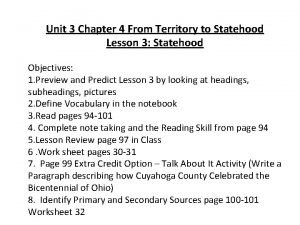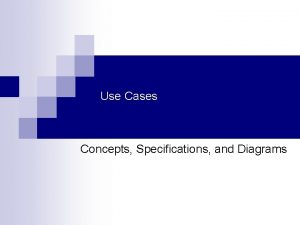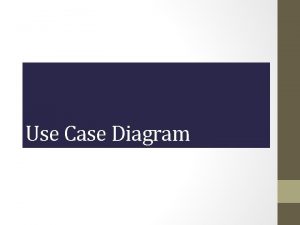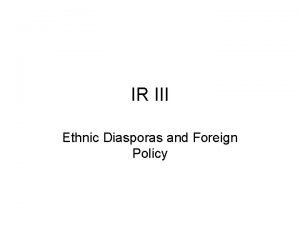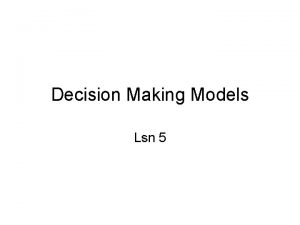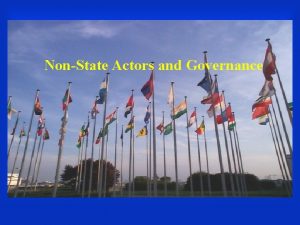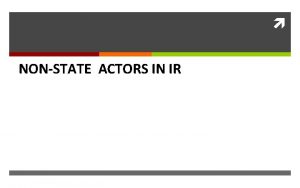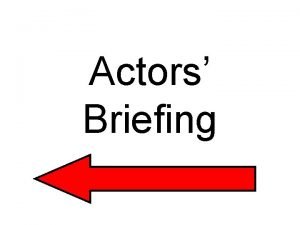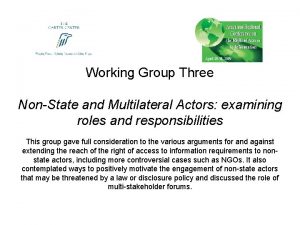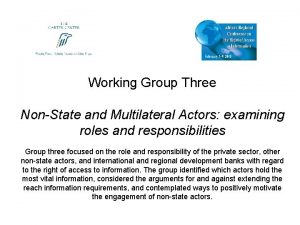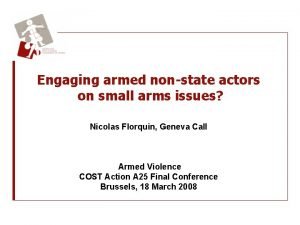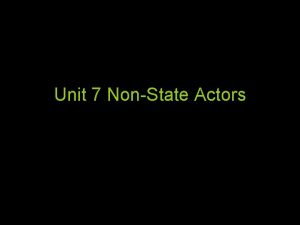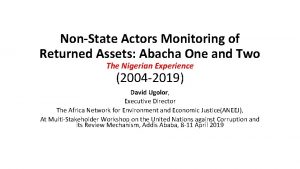Chapter three Types of actors States l Nonstate















- Slides: 15

Chapter three Types of actors: States l Non-state actors l Pre. Mr. Abtidon

Nation-state defined The terms nations, state, country are used to refer to political , economic, social and cultural actors in the international system Pre. Mr. Abtidon

l Nation: A community of people who identify with one another because they share important attributes: language, history, religion, race, culture, common political values. Pre. Mr. Abtidon

v. State: A sovereign government within an established territory. Pre. Mr. Abtidon

Explosion of new states in the 20 th century: l In Middle East after World War I l In Indian subcontinent, Pacific rim & parts of Africa after World War II l In Africa after 1960 l In former Soviet Union after 1990 Pre. Mr. Abtidon

A state refers to a legal/political entity that following: a - a permanent population. b- a defined territory. c- a government. d- The capacity to enter into relations with other states. Pre. Mr. Abtidon

States are identified by mutual recognition. 192 members in the United Nations. As of 2007, the world population has reached six and half billion, and it is estimated to rise to seven billion by 2013. The largest population in the world is in China with 1, 321, 852, 000 persons, followed by India with a population of 1, 129, 866, 000, and third is the USA with 301, 139, 000. The European Union has 490, 426, 000. The smallest population, the Vatican, has 1, 000 persons. Pre. Mr. Abtidon

Types of States The first way to categorize contemporary state actors is by type. Strong, weak, failing, or failed states are defined. v by their ability to control their own territory. v by their capacity to perform core functions. Pre. Mr. Abtidon

Consider the first factor—the ability to control territory. It is a key feature that distinguishes strong states from weak. failing, and failed ones. Territorial control encompasses the ability to monitor and secure borders, including ports and air space, and to maintain government presence throughout the state. Pre. Mr. Abtidon

Strong States Strong states derive the power to rule from competent institutions of coercion. They control their territories and maintain a monopoly of the use of force within their borders. States as varied as the United States, Japan, the member nations of the European Union, as well as North Korea, Russia, Iran, and China can be classified as strong states by these criteria. Pre. Mr. Abtidon

Strong states vary in their ability to provide core functions and in their legitimacy. The United States, Canada, Japan, Australia, and the states of Western Europe deliver a full range of political goods to their citizens and are ranked high in terms of GDP per capita. Pre. Mr. Abtidon

Weak States Weak states exhibit a limited ability to control their own territories or provide core services. The majority of states in the world can be classified as weak by these criteria. These include Mexico, Colombia, Venezuela, Algeria, Thailand, Botswana, Indonesia and the Philippines, among many others. Pre. Mr. Abtidon

Other states are weak because their ability to provide core functions is constrained. The most important state function is the provision of security. Pre. Mr. Abtidon

Failing and Failed States Twenty states in the world can be classified as failing or failed, according to researchers at The Fund for Peace, and another 20 are in critical danger, heading in this direction. Failed states cannot control their territories and provide even the most basic core services, notably security. Pre. Mr. Abtidon

Failed states are not perceived as legitimate by their populations. Somalia, Zimbabwe, the Democratic Republic of Congo, Afghanistan, Burma, and Haiti, among others, meet these criteria. Pre. Mr. Abtidon
 History of three states chapter 4
History of three states chapter 4 What were the 11 free states
What were the 11 free states Is virginia a northern or southern state
Is virginia a northern or southern state Tyranny
Tyranny Use case with multiple actors
Use case with multiple actors Use case primary and secondary actors
Use case primary and secondary actors Use case primary and secondary actors
Use case primary and secondary actors Use case with multiple actors
Use case with multiple actors Actors queue
Actors queue Consists of the actors and forces outside
Consists of the actors and forces outside Actors in foreign policy
Actors in foreign policy Definisi use case diagram
Definisi use case diagram Famous latino singers
Famous latino singers Rational actor model cuban missile crisis
Rational actor model cuban missile crisis Uml diagram for hospital management system
Uml diagram for hospital management system Security actors
Security actors
